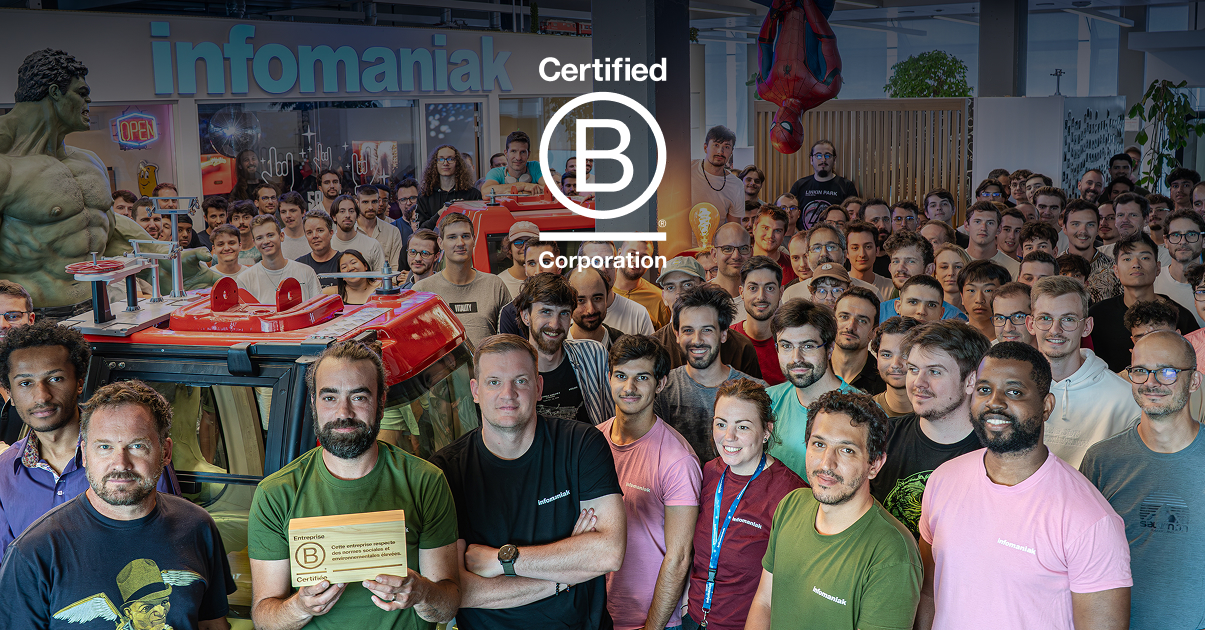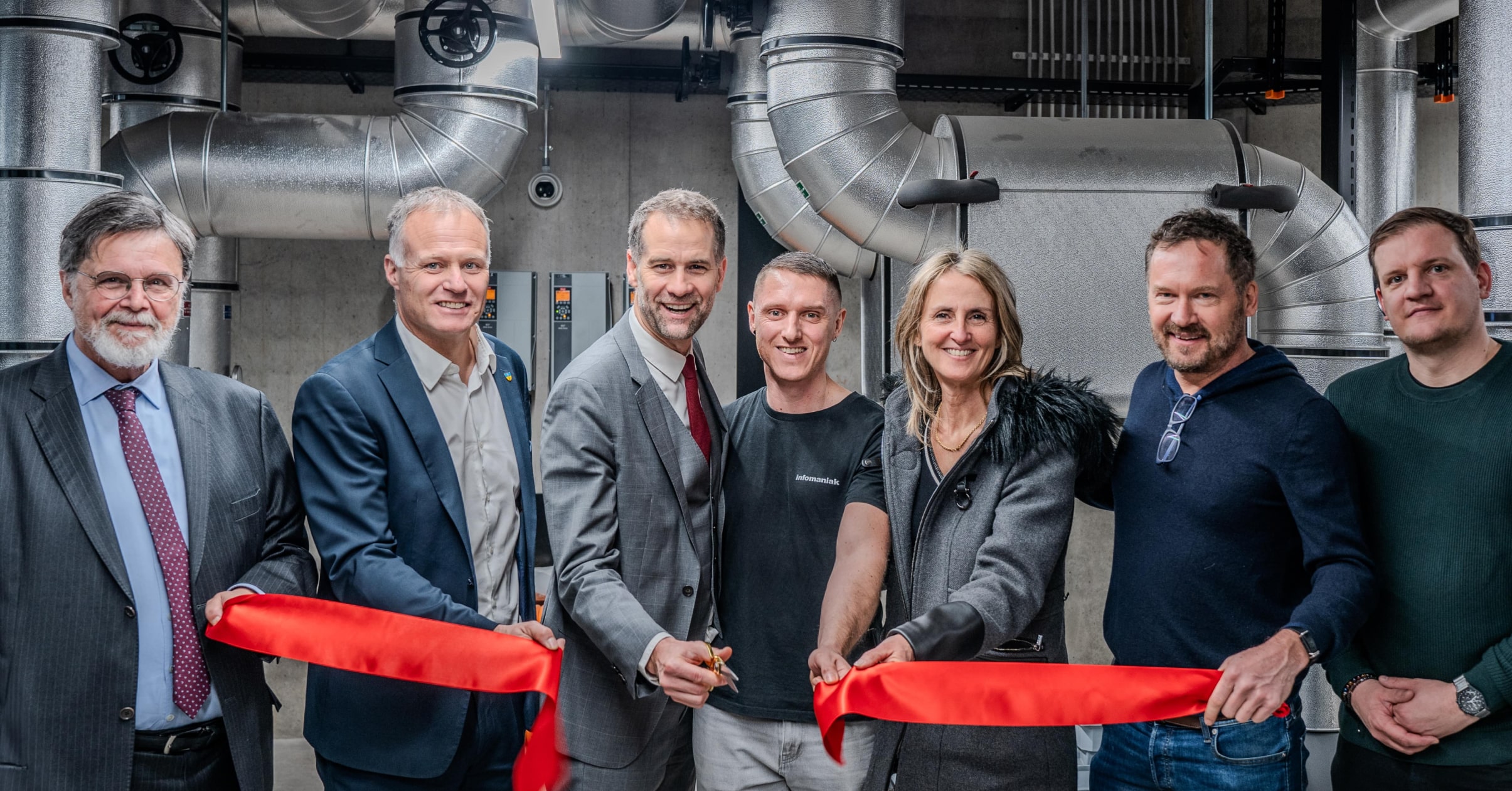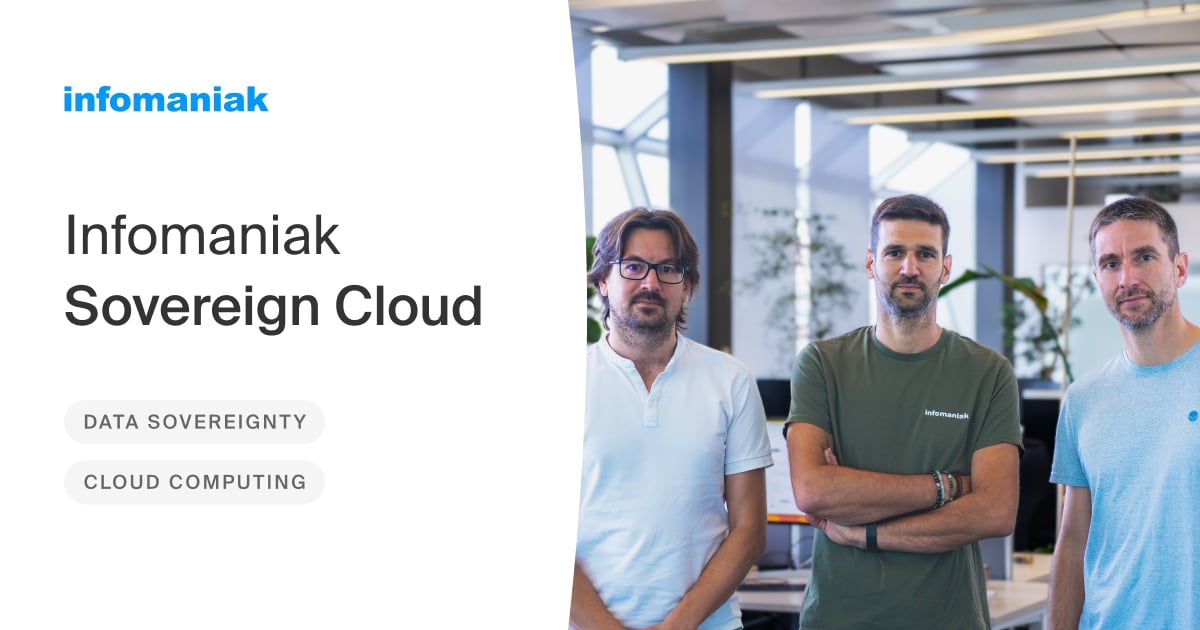As events in the news sadly remind us, there’s no such thing as zero risk. The cloud is fragile – that much is evidenced by the devastating fire at the OVH datacenter. Our Customer Support department received many questions in the wake of this rare event. We’ve decided to answer them in complete transparency in this article.
“The fact that a datacenter has been destroyed must be a terrible crisis for the OVH teams to deal with. This nightmare situation isn’t an option for us, and we’re doing everything possible to avoid it. Boris Siegenthaler, Co-Founder and CSO of Infomaniak
To protect your data, we need to guard against several eventualities such as floods, fires, earthquakes, vandalism, sabotage, cyber attacks and major accidents. Our job is to ensure that your data is protected against these risks.
Our buildings are designed to cope with critical risks

Fireproof building materials
Our datacenters are exclusively made of concrete and iron – two materials that only burn at very high temperatures. Since a server doesn’t have a thermal load that’s high enough to set another server on fire, we ban all fuel-like materials.
Our stock and delivery packaging – which contains cardboard, plastic, wood and SAGEX – is removed to a room away from the servers. This room is equipped with specific extinguishing media for these flammable materials.
Spaces are compartmentalised
Our datacenters are containerised like submarines. For example, our emergency batteries are stored in a dedicated room, equipped with specific extinguishing equipment and isolated from the rest of the facilities by concrete. This is true of all critical equipment. The datacenter’s wings and aisles are also separated by fire doors that are not opened simultaneously.
Automatic detection, alarm and extinguishing system
Our sites are monitored and fully equipped with fire detection systems. Our extinguishing systems, which are calibrated for each type of datacenter environment, ensure automatic extinguishing in areas where a fire could break out. These systems operate in rooms containing electrical equipment such as inverters, batteries or distribution panels. This monitoring system runs continuously and is regularly tested.
We test the viability of our standby facilities in a systematic and planned manner
The standby systems in our datacenters are monitored and tested according to different protocols. The checks and tests are planned as follows:
- automatic tests
- weekly tests
- monthly tests
- quarterly tests
- annual tests
How often the checks are performed depends on the type of check and how important the equipment is. Some parts such as inverters are dismantled, tested individually on a test bench, then reassembled. We test different recovery scenarios such as a general power cut, for example. These tests are carried out twice by two different people, to ensure that we don’t miss anything.
An architecture designed to naturally dissipate heat
Infomaniak’s datacenters are not air-conditioned; they use only natural air. That’s why our facilities are designed from the outset to cool and dissipate large amounts of heat without additional support.
A high level of security with several ISO certifications
Our security and data protection measures form part of an ongoing process that has earned us ISO 27001 and ISO 14001 certification. In practice, this means that we are audited on our risk measures, our checks and our approach to continuous improvement regarding the security of our datacenters, including fire risk. These binding standards are the global benchmark for information security management.
How is your data backed up?
Since 2014, Infomaniak’s new services replicate your data in at least two datacenters and systematically back up your data on a third medium. Other products in our range work differently. So we can classify our products into one of the following three categories.
Triple data (x3): redundancy AND integrated backup
Our new products such as kDrive, Swiss Backup and Infomaniak Mail are redundant on two sites. The data is saved on an additional, separate medium (backup). In short, your data is located in two datacenters, on at least three different media.
Duplicate data (x2): managed services with integrated backup
The vast majority of our services are managed, such as Web Hosting or Managed Cloud Hosting. The latter have no built-in redundancy; instead, they are systematically backed up in another datacenter. So your data is on two media, in two datacenters.
Unmanaged services: autonomous risk management
Our unmanaged services provide dedicated resources that you are fully responsible for. So they are neither redundant nor backed up by default. This complete freedom means you have to enable or set up your replication and backup system independently – by choosing another Infomaniak datacenter, for example. Unmanaged cloud servers and Jelastic Cloud are particularly well-suited to this type of architecture.
What’s the difference between replication and backup of your data?
Data replication is provided by redundant storage. This means that the data is duplicated and accessible in real time from two different media. At Infomaniak, this redundancy takes place in different datacenters.
A backup is a copy of your data, made at regular intervals. The backup is a snapshot of the data at a specific time. If a major incident occurs at either datacenter, this means that your data remains secure and can be quickly accessed again.
You choose the risk you want to take
Choosing a product is a bit like taking out insurance. You should choose an offer that reflects your ability to assume the risk of data loss.
Option 1: we manage everything for you (most of our products)
If you don’t want to take the risk of data loss, choose a product managed by Infomaniak. As explained above, these products include a double or triple storage location for your data as standard.
Option 2: you manage the risk independently
This is the principle of our unmanaged services. If you don’t know how to evaluate or set up what is needed for your project, we advise that you get professional help. Our partner platform allows you to rapidly receive free quotes from experienced professionals who have a clear, in-depth understanding of our infrastructure and products.
We focus on reliability and robustness rather than cost optimisation
Due to our position, we are forced to pursue a constant quest for perfection at all levels. This quest for quality is an integral part of our DNA, which is why we mainly offer managed services that don’t require any additional facilities in parallel.
A sustainable and premium vision of hosting
Rather than consolidating all your data in one giant datacenter, we prefer taking a decentralised, multi-datacenter approach. Discreet and small in size, these datacenters limit risk because fewer customers can be impacted if a problem occurs. They improve redundancy and are ideally integrated into the local energy supply network landscape.
As our services evolve, we systematically migrate all our customers to the latest developments in our infrastructure. We were the first to switch all our customers to 100% SSD storage or to offer Let’s Encrypt SSL certificates for free, for example. This unique approach explains why we don’t have the same pricing policy as low-cost providers, who are more aggressive on prices.
Our datacenter fleet is sustainably and gradually evolving
Infomaniak’s datacenters are just like our growth: gradual and sustainable. They are planned and developed on a time scale that’s in line with our environmental goals. In other words, they don’t pop up like mushrooms; rather, they are the result of long-term strategic planning.
Our oldest datacenter (which had become obsolete due to our rising standards) was closed three years ago and replaced by two Tier3+ datacenters located in the Canton of Geneva. Two new datacenters will be built soon: one in Plan-les-Ouates in 2023, and another in the Canton of Zurich in 2026. Their location and technology mean the heat that the servers generate can be used to heat residential areas.
Tier3+ datacenters are among the most efficient in the world
Our expertise in datacenter design gives us the means to build a secure, reliable and redundant infrastructure. Tier3+ datacenters have redundant equipment and multiple network and power distribution paths. With a power usage effectiveness (PUE) of less than 1.1, our datacenters are among the most efficient in the world, well ahead of the industry giants.
A datacenter fire is a rare occurrence
“A datacenter burning down is extraordinarily rare. Occasionally, work can cause temporary damage to buildings (an excavator cutting through cables, for example). But a fire like that is incredible,” remarked Marc Oehler, CEO of Infomaniak, to Le Temps newspaper.
It’s true; datacenters don’t pose any particular risk of fire, especially since they are specifically designed to avoid it. So a fire is less likely to break out or even destroy a datacenter, since all the attention is focused on this type of danger.
According to Julien Bonnat, datacenter Operations Manager:
“All the measures taken in Infomaniak’s datacenters make destruction of a datacenter by fire unrealistic.” He said: “It’s the stacking of the different protective measures we have that make the spread of a fire inconceivable.”
The real threat comes from cybercrime
The risks associated with online crime are the most significant threat to data integrity. This is why Infomaniak’s datacenters are so discreet. They blend into the landscape, and their location is not disclosed. This is also why we encrypt all data, develop our own technologies and automatically and proactively patch the CMS.
Security by design
Security is a structural foundation of our company. We implement measures to protect both your data and privacy from the very first stages of development. We monitor our technologies to detect abnormal behaviour or threats and respond in a timely manner. Proactive hardware, software and human resources complement our facilities. They are described in detail in this article, which we recommend you read if you are interested in the topic.
***
We hope that this article answers the questions that have been raised by this unfortunate event and assure you that we’ve already done everything we can to guarantee the integrity and security of the data entrusted to us.
Thank you for the trust you place in us
Find out more
Infomaniak inaugurates a revolutionary data center that recovers 100% of its energy to heat buildings
Tuesday January 28th, 2025

 Français
Français Deutsch
Deutsch Italiano
Italiano Español
Español





You must be logged in to post a comment.